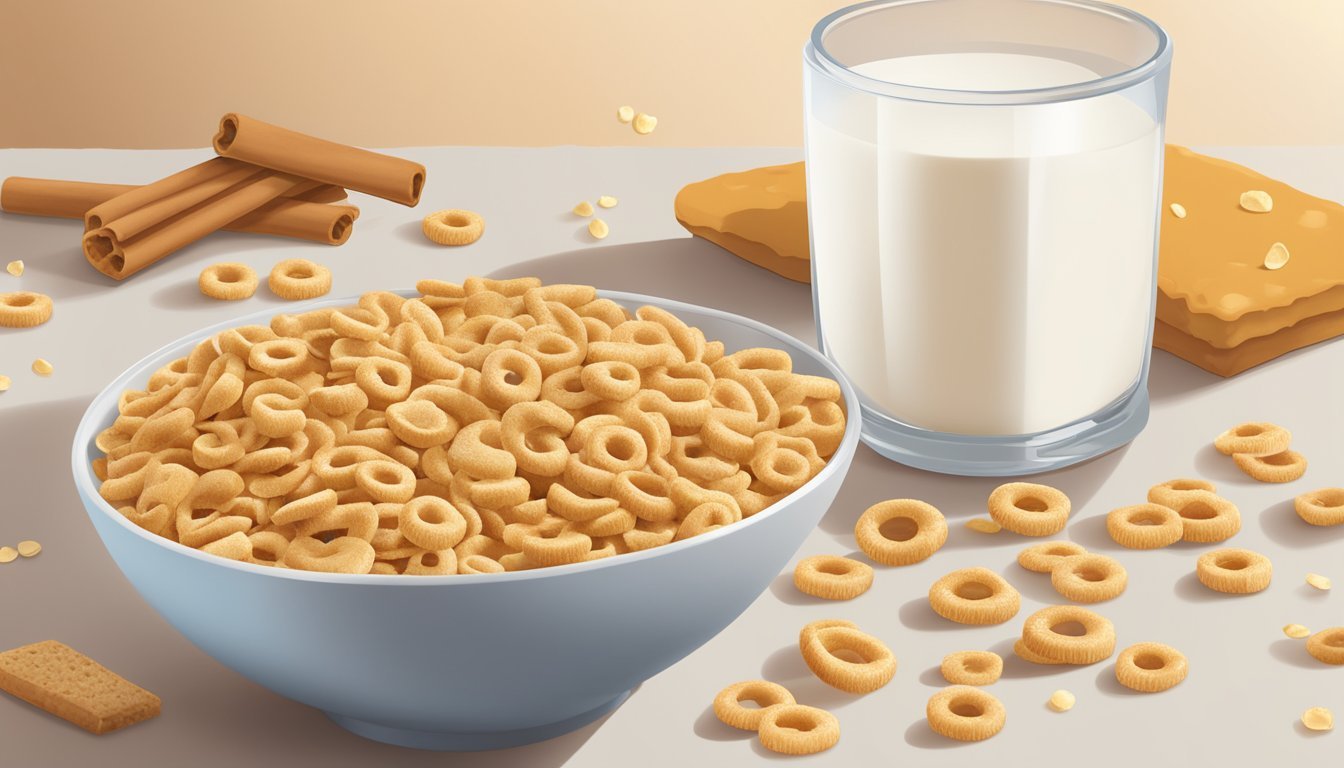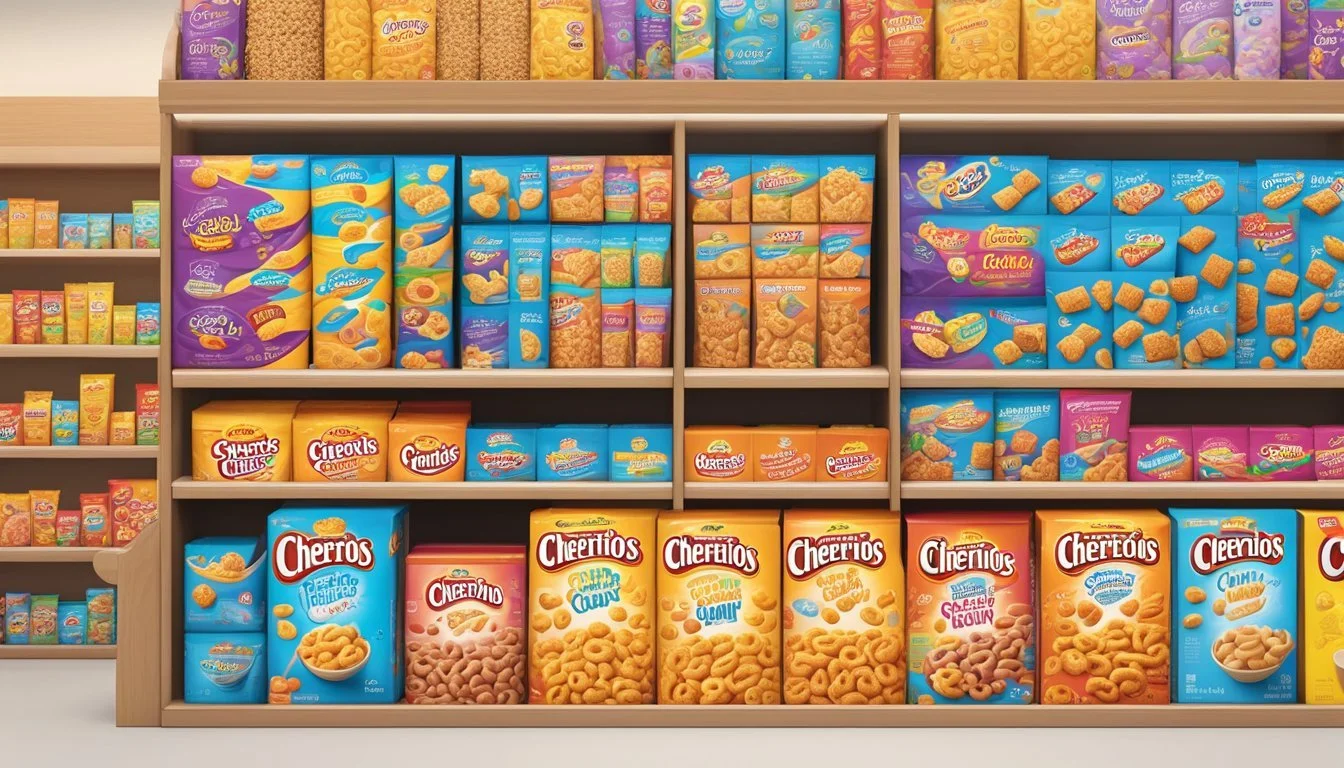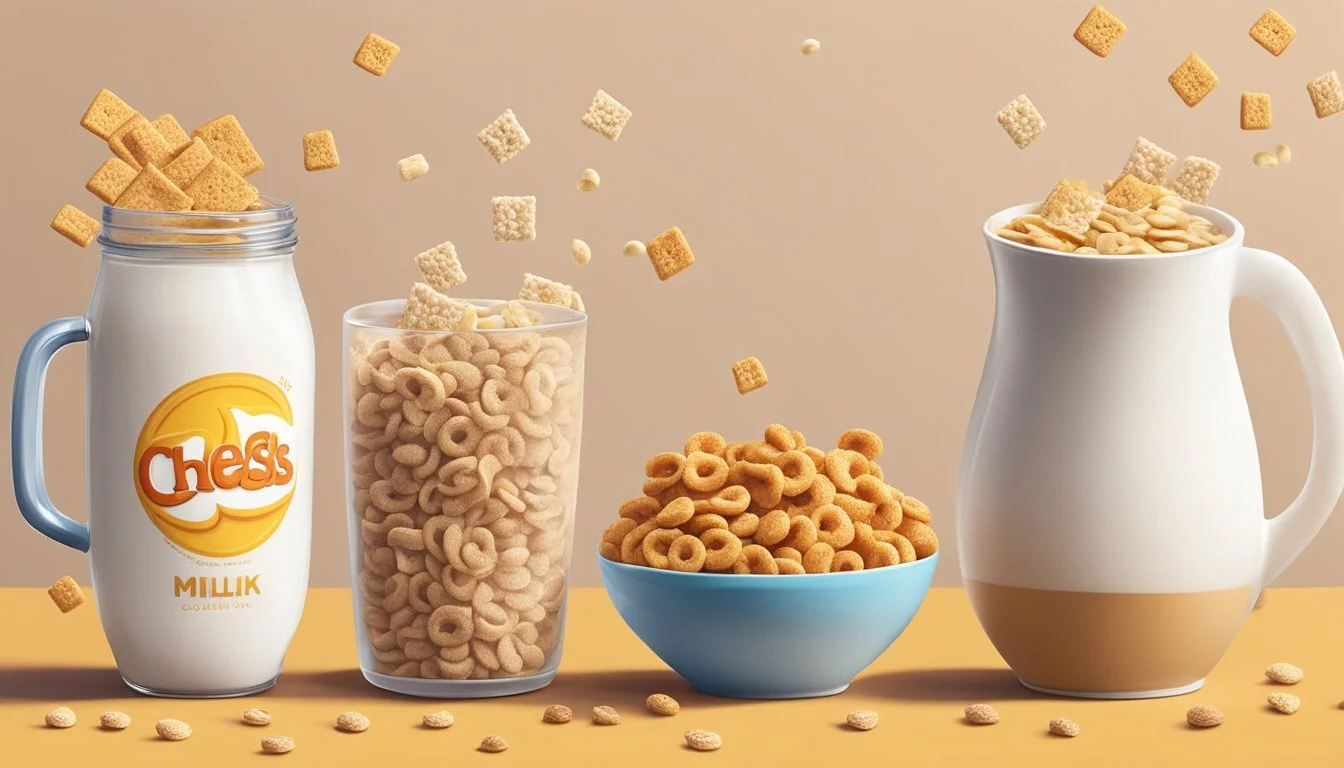Cheerios vs Cinnamon Toast Crunch
A Nutritional and Taste Comparison
This Article is Part of Our Breakfast Cereal Guide with Details on Cheerios Nutrition and Cinnamon Toast Crunch Nutrition
When it comes to choosing between Cheerios and Cinnamon Toast Crunch for breakfast, both cereals offer unique benefits and flavors. Cheerios are well-known for their heart-healthy qualities, thanks to their whole grain oat base and minimal sugar content. On the other hand, Cinnamon Toast Crunch provides a deliciously sweet, cinnamon-sugar experience that has made it a favorite among children and adults alike.
In terms of nutritional content, Cheerios contain 17.0 grams of complex carbohydrates per serving, which can help sustain energy levels throughout the morning. Contrastingly, Cinnamon Toast Crunch has 13.0 grams of complex carbohydrates, balanced by a higher sugar content that might appeal to those with a sweet tooth. Despite this, the fiber and protein in Cinnamon Toast Crunch can still make it a viable choice for a quick, filling snack.
Ultimately, the decision between Cheerios and Cinnamon Toast Crunch may boil down to personal preferences and dietary goals. While Cheerios offers a more health-conscious option with its lower sugar and higher complex carbohydrate content, Cinnamon Toast Crunch stands out for its irresistible flavor profile and balanced nutrition, making both cereals worthwhile candidates for your breakfast table.
Background of the Brands
General Mills has been a key player in the breakfast cereal market, shaping consumer preferences with products like Cheerios and Cinnamon Toast Crunch. Both brands have unique histories and significant impacts on breakfast tables across the globe.
General Mills' Role in Breakfast Cereals
General Mills, an American multinational manufacturer of food products, has been influential in the cereal market since its inception.
Founded in 1928, the company is headquartered in Minneapolis, Minnesota. Cereal production became a substantial part of its portfolio, contributing to its growth and reputation.
Some of the most beloved breakfast cereals in the United States, including Cheerios and Cinnamon Toast Crunch, originate from General Mills' production lines.
Evolution of Cheerios
Cheerios, introduced in 1941 as "CheeriOats," is one of General Mills' flagship products. The brand's name was changed to Cheerios in 1945.
Known for its distinctive O-shaped pieces made primarily from whole grain oats, it quickly became popular for its simplicity and health benefits.
Cheerios have since expanded into different varieties, including Honey Nut Cheerios, one of its most successful variants. The brand's emphasis on heart health and whole grains makes it a popular choice among health-conscious consumers.
Popularity of Cinnamon Toast Crunch
Cinnamon Toast Crunch was launched by General Mills in 1984.
This cereal is renowned for its square-shaped pieces coated with cinnamon and sugar. Its unique flavor profile and texture make it a favorite among children and adults alike.
The branding emphasizes a fun, flavorful breakfast experience, contributing to its strong market presence. Cinnamon Toast Crunch continues to evolve, with new variations and marketing strategies keeping it relevant in the competitive cereal market.
Nutritional Profiles
The nutritional profiles of Cheerios and Cinnamon Toast Crunch reveal significant differences in key areas such as carbohydrates, vitamins, and sugar content. This analysis uncovers the specifics that make each cereal unique in its nutritional offerings.
Core Nutritional Data
The basic nutritional data for Cheerios and Cinnamon Toast Crunch shows variations in caloric intake, fat, and protein. Cheerios has approximately 100 calories per 1-cup serving, with 2 grams of fat and 3 grams of protein. Cinnamon Toast Crunch contains about 130 calories per 3/4-cup serving, along with 3 grams of fat and 1 gram of protein.
In terms of complex carbohydrates, Cheerios offers 17 grams per serving, whereas Cinnamon Toast Crunch has 13 grams. These differences are critical for those managing caloric and macronutrient intake.
Vitamins and Minerals
Cheerios stands out with its higher fortification of vitamins and minerals compared to Cinnamon Toast Crunch. One key element is iron; Cheerios covers 159% of the daily iron needs, while Cinnamon Toast Crunch falls significantly behind.
Selenium is also notably higher in Cheerios, providing 24.9 micrograms per serving compared to Cinnamon Toast Crunch’s 4.7 micrograms. Both cereals are fortified with essential vitamins such as Vitamin C, Vitamin B6, Vitamin B12, and Vitamin D, but Cheerios typically offers higher percentages of these vitamins.
Sugar and Fiber Content
Fiber and sugar content are also important differentiators. Cheerios contains 4 grams of dietary fiber per serving, which helps in promoting digestive health. Cinnamon Toast Crunch offers only 2 grams.
When it comes to sugar, Cinnamon Toast Crunch contains 9 grams per serving, much higher than the 1 gram found in Cheerios. For those concerned about sugar intake, this is a considerable difference. The lower sugar content in Cheerios makes it a more suitable choice for a heart-healthy diet.
These disparities highlight the distinct nutritional advantages and drawbacks of each cereal, aiding in more informed dietary choices.
Health and Diet Considerations
Cheerios and Cinnamon Toast Crunch offer different nutritional profiles. These differences influence their suitability for gluten-free diets, potential allergies, and various dietary needs.
Gluten-Free and Allergy Information
Cheerios are widely known for their gluten-free options. This makes them a safe choice for individuals with celiac disease or gluten sensitivities. Regular Cheerios are made from oats, which are naturally gluten-free, though it's important for consumers to check for potential cross-contamination in the manufacturing process.
Cinnamon Toast Crunch, on the other hand, is not gluten-free. The presence of wheat makes it unsuitable for anyone avoiding gluten. Allergy awareness extends beyond gluten. Cheerios are free from common allergens like nuts. Conversely, Cinnamon Toast Crunch may contain traces of nuts and soy, which are potential allergens for some people.
Suitability for Various Diets
Cheerios cater to a broader range of dietary needs. They are low in sugar, high in fiber, and come in a variety of flavors, including low-sugar options. These factors make them suitable for diabetic, heart-healthy, and weight management diets.
Cinnamon Toast Crunch is higher in sugar content, which might not be ideal for those on low-sugar or diabetic diets. The cereal's higher sodium content also makes it less suitable for low-sodium diets. However, its taste and texture make it a popular choice among children and individuals looking for a more indulgent cereal option.
While both cereals have their merits, Cheerios generally offer more favorable health and dietary profiles for a wider audience.
Taste and Texture Analysis
Cheerios and Cinnamon Toast Crunch offer distinct experiences that appeal to different preferences. This section breaks down their flavor profiles and textures.
Flavor Profiles
Cheerios have a mild taste, making them versatile for various palates. The original flavor is subtly sweet with a hint of oat, balanced well for those who prefer less sugary options. Honey Nut Cheerios adds a touch of honey and almond, amplifying its sweetness without being overpowering.
Cinnamon Toast Crunch is renowned for its strong cinnamon-sugar flavor, which is both bold and satisfying. Each bite offers a sweet explosion of sugary spice, creating a distinctly different experience from the understated toastiness of Cheerios.
Texture Comparison
Cheerios are small, round, and lightly crunchy. They maintain their texture well in milk, holding up without getting too soggy. This makes them a reliable choice for those who enjoy a consistent crunch from start to finish.
Cinnamon Toast Crunch provides a more intense crunch due to its shape and thicker structure. The pieces stay crisp in milk for a decent amount of time but can become softer if left too long, offering a varied texture experience throughout the meal.
In summary, Cheerios are predictable and steady, while Cinnamon Toast Crunch engages the palate with more extreme texture changes.
Consumer Perspectives
When comparing Cheerios and Cinnamon Toast Crunch, it is essential to consider market performance and brand loyalty, which inform consumer preferences and influence their choices.
Market Performance
Cheerios remains a staple in the breakfast cereal market. Its appeal lies in its health-focused branding, targeting consumers who prioritize nutrition. General Mills, the manufacturer, reported steady sales, though with slight fluctuations. Cheerios often appears in lists of top cereals, reflecting strong consumer trust and consistent demand.
Cinnamon Toast Crunch, also produced by General Mills, boasts high sales figures, appealing primarily to taste-oriented consumers. Despite a slight decline in recent sales data, it remains a popular choice, particularly among younger demographics. Its unique taste and crunchy texture contribute to its lasting market presence and consumer satisfaction.
Brand Loyalty and Appeal
Consumers who prefer Cheerios appreciate its health benefits, such as low sugar content and high fiber. This cereal frequently garners positive consumer ratings for its nutritious value. Many loyal customers cite Cheerios as a go-to for a balanced diet, often introducing it to their children, creating multi-generational brand loyalty.
Cinnamon Toast Crunch enjoys a different type of loyalty. Fans are drawn to its cinnamon-sugar flavor, often nostalgic for childhood memories. This strong emotional appeal keeps consumers coming back. The brand's active marketing campaigns and social media presence enhance its visibility and consumer engagement, reinforcing its fun, indulgent image.
Variants and Flavors
When comparing Cheerios and Cinnamon Toast Crunch, it’s essential to consider the variety of flavors and spin-offs each brand offers. Understanding these choices can help one make a more informed decision based on personal preference and nutritional needs.
Cheerios Variants
Cheerios come in an array of flavors and variants to suit different tastes. Honey Nut Cheerios is perhaps the most famous variant, known for its sweet and nutty flavor. Another popular type is the Apple Cinnamon Cheerios, which combines the classic oats with a hint of apple and cinnamon.
Banana Nut Cheerios offers a blend of banana and nut flavors, making it a distinctive choice. For those focusing on a health-conscious diet, Cheerios Oat Crunch varieties, including Oats 'n Honey and Cinnamon Oat Crunch, provide added texture and a slight sweetness. Multigrain Cheerios, a blend of five whole grains, are also a nutritious option. Cheerios have expanded their offerings to include chocolate, berry, and even limited-edition flavors, catering to both children and adults.
Cinnamon Toast Crunch Spin-Offs
Cinnamon Toast Crunch has expanded its brand with several spin-offs, maintaining its signature cinnamon-sugar flavor while offering new experiences. Cinnamon Toast Crunch Churros deliver a crunchier texture with the same beloved taste shaped like mini churros. Another variant is Chocolate Toast Crunch, adding a chocolate twist to the cinnamon-sugar base.
For a fruitier option, Apple Cinnamon Toast Crunch combines apple flavors with the classic taste. Cinnadust, a product that allows consumers to sprinkle the signature cinnamon-sugar blend on various foods, brings versatility. Most of these variants stick closely to the core elements of the original, ensuring they retain the brand's familiar appeal while providing new ways to enjoy that signature flavor.
Both Cheerios and Cinnamon Toast Crunch exhibit a wide range of flavors and variations, each catering to distinct tastes and preferences.
Serving and Consumption
Understanding how much to serve and how to pair these cereals can influence both their nutritional benefits and consumer enjoyment.
Recommended Serving Sizes
Cheerios typically recommends a serving size of 1 cup, weighing about 1 ounce. This size contains approximately 100 calories, 2 grams of fat, and 17 grams of complex carbohydrates. These nutritional values make Cheerios a suitable option for breakfast or a light snack.
Cinnamon Toast Crunch's recommended serving size is 3/4 cup, weighing about 1 ounce. This serving provides around 130 calories, 3 grams of fat, and 25 grams of carbohydrates, including 9 grams of sugar. The higher sugar content makes it a sweeter choice and potentially less suitable for those monitoring their sugar intake.
Pairs and Combinations
Cheerios can be paired with a variety of foods to enhance its nutritional profile. Adding fresh fruits like berries or banana slices increases vitamin and fiber content. For added protein, a handful of nuts or a spoonful of Greek yogurt can be incorporated.
Cinnamon Toast Crunch also pairs well with fresh fruit, though its sweeter flavor profile often makes it a standalone choice for many. Combining it with milk or a dairy-free alternative can provide additional calcium and protein. Mixing it with other cereals, such as plain oats, can help balance the sugar levels for a more nutrient-dense meal.
Both cereals can be versatile components of balanced meals, allowing for creative combinations tailored to individual dietary needs and preferences.
Environmental and Ethical Aspects
Both Cheerios and Cinnamon Toast Crunch have made efforts to address their environmental and ethical responsibilities. This includes launching sustainability initiatives and ensuring ethical sourcing and production of their ingredients.
Sustainability Initiatives
General Mills, the company behind both Cheerios and Cinnamon Toast Crunch, has committed to several sustainability goals. They aim to reduce their greenhouse gas emissions by 30% across their entire value chain by 2030. Moreover, they are working towards achieving zero waste to landfill at all their production facilities.
The company also focuses on minimizing water usage. For instance, General Mills has implemented advanced water-saving technologies in their manufacturing processes. Recycling and renewable energy use are other critical aspects, with several facilities already transitioning to solar and wind power.
Ethical Sourcing and Production
General Mills places significant emphasis on ethically sourcing ingredients. They ensure that suppliers adhere to strict labor standards and fair trade practices. For example, the company sources non-GMO oats for Cheerios, promoting transparency and consumer trust.
The company also supports farmers through various initiatives. Programs like the Global Responsibility Report outline how they aid farmers in adopting more sustainable agricultural practices. Additionally, General Mills collaborates with local communities to improve agricultural productivity while maintaining environmental health.
By prioritizing humane labor practices and environmentally-friendly farming techniques, General Mills strives to align with robust ethical and sustainability benchmarks.
More on Cheerios
More on Cinnamon Toast Crunch
Cinnamon Toast Crunch vs French Toast Crunch: Which is better?
Cinnamon Toast Crunch vs Honey Nut Cheerios: Which is better?
Cinnamon Toast Crunch vs Kellogg's Apple Jacks: Which is better?
Cinnamon Toast Crunch vs Kellogg's Froot Loops: Which is better?
Cinnamon Toast Crunch vs Post GrapevsNut Flakes: Which is better?
Cinnamon Toast Crunch vs Post Raisin Bran Cereal: Which is better?









